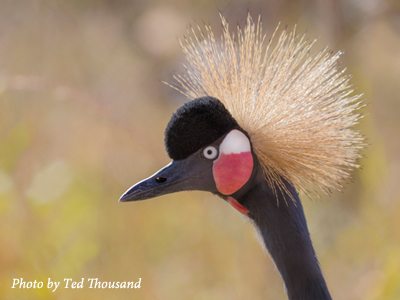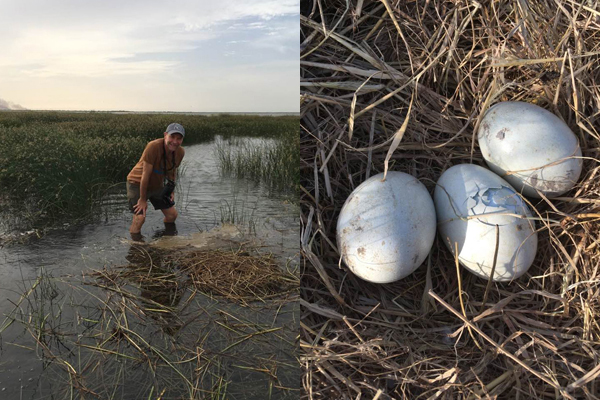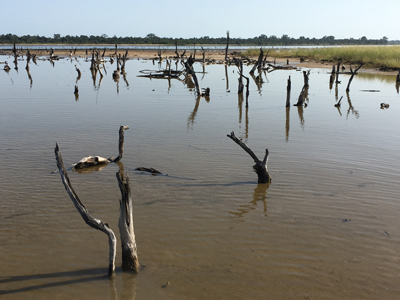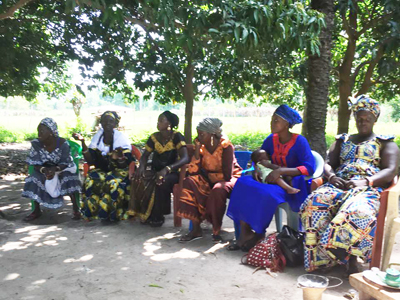Last month I traveled to the vast floodplains of Senegal with our Africa Programs Manager, Kerryn Morrison, to learn about the status of Black Crowned Cranes in West Africa and plan conservation actions in the region. Our goal was to re-establish our Black Crowned Crane conservation program in West Africa, building on the major program the International Crane Foundation and key partners had in the region 15 years ago.

We traveled with our colleague Idrissa Ndaiye to two of the strongholds for Black Crowned Cranes in West Africa – the Senegal Delta in Djoudj National Park on the northern Senegal border with Mauritania, and the Casamance Delta on the southern Senegal border with Guinea Bissau. Our estimates from 15 years ago put the crane population across this region at more than 3,000.
Black Crowned Cranes are the least understood of all crane species – there are very few published studies about the birds, very few good photos of them in the wild (almost none from West Africa), and even the basics of their nesting and foraging ecology is poorly known and mostly assumed from observations in a just a few places.

Much of our time was spent searching for nests, as few breeding locations are known for the species in Senegal. We were surprised to learn that Black Crowned Crane nests are much more similar to the highly-aquatic Wattled Crane than their cousins, the Grey Crowned Crane. The nests are a simple platform made of local reeds and grasses, surrounded by deep water. Soon after hatching, the chicks must swim to higher ground – sometimes more than 50 meters. We discovered one of only three nests ever found at Djoudj National Park (one nest with a pipping egg!), and about 15 nests at Casamance. There are no doubt many more, well-hidden nests in the region.

The floodplains where Black Crowned Cranes nest are increasingly saline. The local people attribute this change to episodic droughts and the impacts of climate change – higher temperatures and increasing evaporation, coupled with decreasing rainfall across the region. Studies back this up, but the rapid impact of this change is startling. A massive die-off of wetland forest and mangrove is occurring over great distances, with stumps of trees appearing as watery tombstones. This salinization is causing great hardship for the local people, who must dig deeper and deeper wells each year to get freshwater.
I am increasingly convinced that Black Crowned Cranes are among the most endangered cranes of the world. Black Crowned Cranes face some conservation challenges that are familiar from the Endangered Grey Crowned Crane’s story. Loss and disturbance of wetland habitat is a major concern for the species, as is capture for international trade/regional domestication – and the one often closely follows the other. Many Black Crowned Cranes are fully domesticated and roam about like chickens or peacocks, a status symbol for the family compound. Presumably because they are frequently captured in the region, Black Crowned Cranes are incredibly skittish around people. We struggled most of the time to get within 100’s of meters from the cranes – they were constantly on alert and flew within seconds of us stopping our car or boat, even when feeding a great distance away.
But most alarming, is that many of the known strongholds for Black Crowned Cranes have been overrun by Boko Haram, the Islamic militant group that was responsible for kidnapping the large group of Nigerian secondary school students in 2014. Most of West Africa, including Senegal, is comprised of peaceful Muslim societies that have been terrorized by Boko Haram with little support from the outside world. The impact on Black Crowned Cranes is unknown, but war and cranes are often a bad mix.

Given all this, our renewed efforts to protect the cranes in Senegal and coastal West Africa, as well as our ongoing efforts to save the Black Crowned Crane in Ethiopia, are of utmost importance to keep this species in the wild while we wait for a better future in much of West and Central Africa. I am very encouraged by the dedicated work of Idrissa — a great champion for cranes, who has walked hundreds of miles of shallow marsh in search of cranes and their nests. And I was delighted to meet the wonderful community groups who have dedicated themselves to watching over the birds and their habitats. We look forward to working with these groups as we invest more deeply in the region.
 Story submitted by Dr. Rich Beilfuss, President & CEO of the International Crane Foundation. Click here to learn more about our work in Sub-Saharan Africa.
Story submitted by Dr. Rich Beilfuss, President & CEO of the International Crane Foundation. Click here to learn more about our work in Sub-Saharan Africa.
